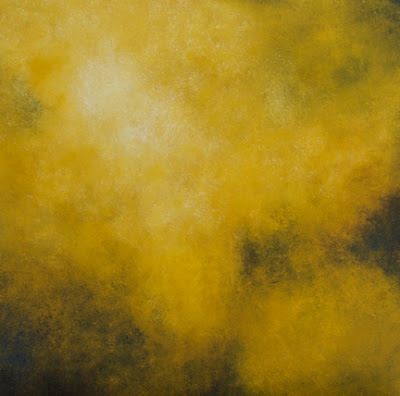 |
| Silence 30 50x50" oil/cold wax on panel © 2013 Janice Mason Steeves |
When I return from a journey, I let the experience wash through me, not knowing what effect it will have on my work. I just begin to work, and after I have a few paintings under my belt, I stand back to see what's happening. Then I realize that it could be a colour I saw that influenced me or the lines on the standing stones, or even something someone said to me.
I always find that I am slow to really settle into a trip, especially when it requires that I paint. For me, painting is about place; my relationship with the place I am in. In his new book: The Old Ways, A Journey on Foot, Robert MacFarlane says that "the two questions we should ask of any strong landscape are these: firstly, what do I know when I am in this place that I can know nowhere else? And then, vainly, what does this place know of me that I cannot know of myself?"
I painted in the beautiful artist residency at Cill Rialaig in Ireland last November, but I also needed the second part of my journey-at the Abbey in Iona- to spend the time in contemplation rather than intensely working and trying to quickly digest the landscape as I was doing in Ireland. I learned that I just need to walk to feel the land where I am. I'm even wondering if painting during a residency is necessary for me, or if I need to spend time just walking, absorbing and thinking thoughts that I may not have at home.
The second part of my journey that I spent on the island of Iona, in Scotland-away from my paints-afforded me the time to walk up and down the wild beaches, collecting stones, listening to the surf and contemplating--thinking about my work and my life. How little value we put on this.
I remember reading a story about Joseph Campbell. My memory of the story goes like this: Campbell and his wife had rented a small country home for a few months. A neighbour looked over the fence to see Campbell reading and said to him, "Oh, I see you are taking a break from work". Campbell replied, "No, I'm not taking a break, I'm working". Another time the neighbour again looked over and saw Campbell chopping firewood and said, "Oh I see that you're working now". Campbell replied, "No, I'm taking a break".
When I came home from my trip in early December. I went into my studio to take a look at the work I had done before I went away. You look at your work with fresh eyes when you see it again after being away for several weeks. It felt clear to me that I should continue in the direction the work was going. As the series is developing since the trip, it has changed slightly. It has become even quieter and softer. And with the increasing chaos in the world -the drastic weather changes, noise, media-bombardment, the violence-in Syria, in India, in Sandy Hook and here at home as well, I am more committed to working in a way that speaks of finding a still quiet centre.
I like that story about Joseph Campbell.
ReplyDeleteHI Roberta,
DeleteI think the story about Joseph Campbell was from the book: A Fire in the Mind by Stephen and Robin Larsen.
Thanks
Janice
I think that every journey involves a sea-change whether we celebrate that or not. Mine last year was soul shaking in so many good ways. Thank you again for your guidance as I made my preparations. In an unforeseen way it made my perceptions brighter as my expectations were set in a new way. I enjoy reading about your process. Thank you for sharing it here.
ReplyDeleteHi Judy,
ReplyDeleteI'd love to hear more about your experiences at your residency. Yes, I think that residencies are terrific for sort of shaking us up!
Thanks for your words,
Janice